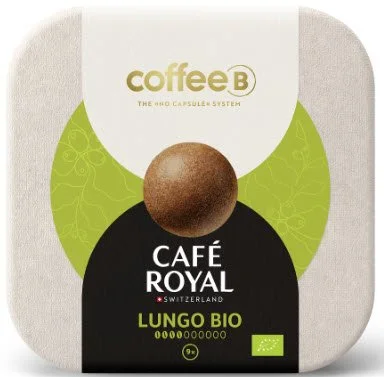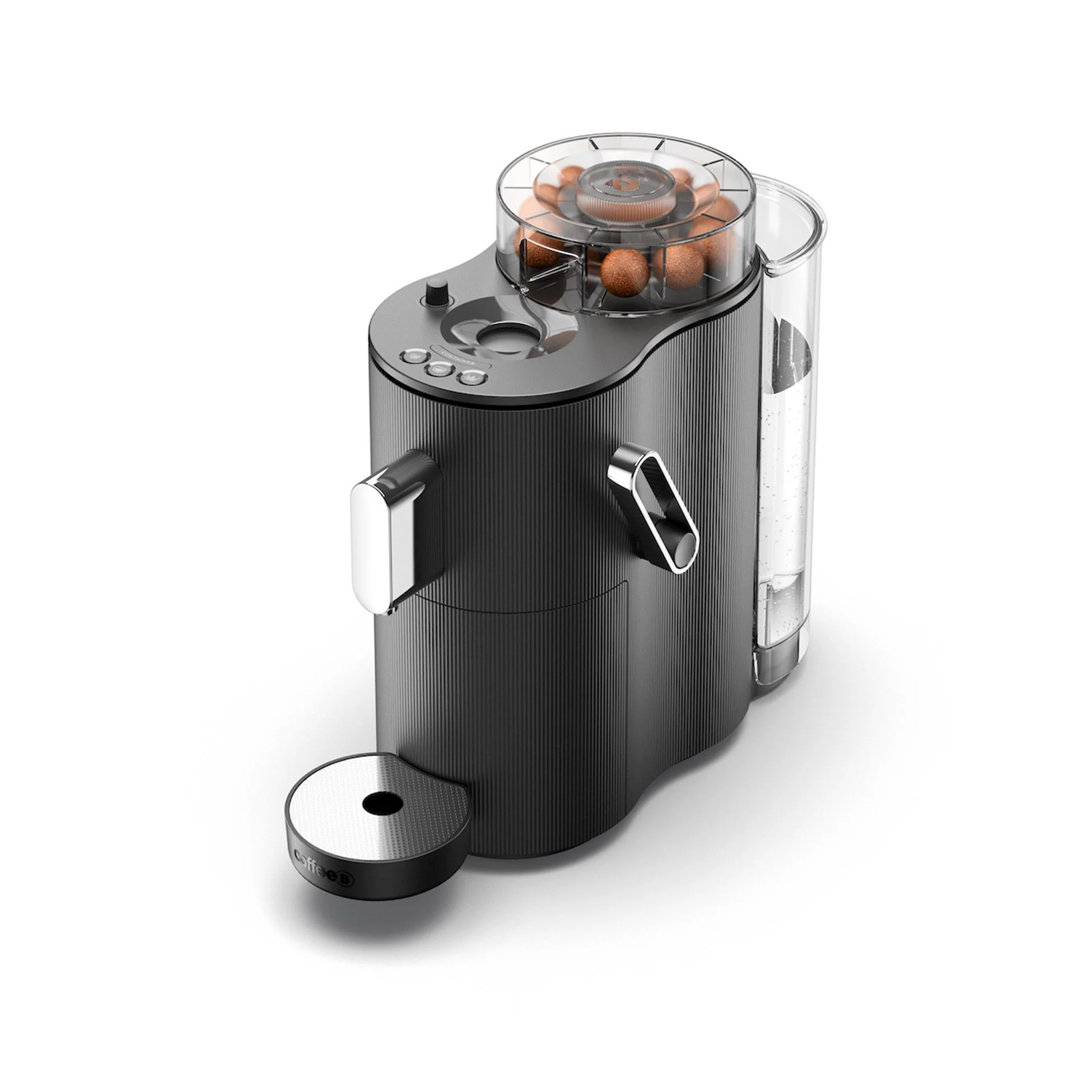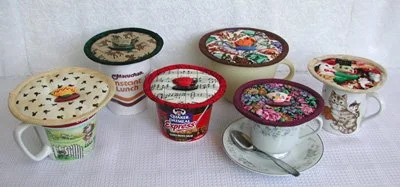Coffee balls: Another cozy way to make coffee on the go
By Perry Luckett, CoffeeMan1
We’ve all seen plenty of balls in our lives: footballs, basketballs, soccer balls, baseballs, softballs, and even—thanks to Saturday Night Live—“Schweddy Balls” from fake entrepreneur Pete Schweddy (Alec Baldwin). But until recently we hadn’t seen coffee balls as a convenient way to brew our coffee on the go.
Enter the coffee ball, created by CoffeeB for Migros in Switzerland, which gives you an alternative to the capsule systems of Nespresso™, Keurig™, and other similar companies. Of course, if you’re a home roaster or a connoisseur of coffee beans, single-serve pods, bags, or balls won’t replace your established coffee routine. But this new brewing method may greatly reduce the environmental impact of one-cup-at-a-time coffee drinking because it leaves no plastic or paper shell behind.
The idea of using seaweed for single-serve coffee applications isn’t new. For example, a company called Notpla™ (for not plastic) introduced this type of environmentally friendly, dissolvable packaging in 2021. The London-based startup benefited from $13 million dollars in Series A funding led by Horizon Ventures. Their new packaging is made of processed seaweed, meaning it has no flavor but does add nutritional value through fiber and antioxidants.
Their goal is to replace plastic films found in food packaging, which can be difficult to recycle, with something more sustainable. Many single-serve options, including tea bags, are made of plastic, and a single bag can release as much as 11 billion micro size pieces of plastic and 3 billion nano size particles into hot water. With Notpla, that number reduces to zero. [ZC1]
I applaud this development but find the coffee-ball solution even more intriguing.
How coffee balls are made: a cozy new process
As suggested by their name, coffee balls are spheres of pre-ground condensed coffee. You’re probably wondering how condensed coffee can maintain its shape through various stages of manufacture, distribution, and brewing. CoffeeB™ wondered too, but fortunately they resolved the problem with two special features of their system.
First, they wrap around the sphere a seaweed-derived thin outer layer that the company describes as tasteless and colorless. This layer provides a hard, capsule-like structure that protects the coffee ball and maintains its freshness. [HB] It doesn’t dissolve during brewing and remains around the grounds throughout extraction. You can then throw it in the trash with the grounds and know that it’s biodegradable over time. Or, better yet, it can join the grounds in your home garden to decompose into dark, nutrient-rich organic matter known as humus within four weeks.
The blend and roast type are laser-etched onto the seaweed casing. As long as you keep it at room temperature or in the fridge, each ball should last for up to three months after you open its package. [BC] The system is launching with a variety of eight blends of coffees that are either Rainforest Alliance, USDA Organic, or Fairtrade certified.
Any downsides to coffee-ball brewing that press against success?
The growth of pod players may pose a challenge to CoffeeB’s trying to crack the single-cup market, especially as Nespresso and others move more toward refillable pods or, especially, compostables. More players in the pod market also give consumers like you more choice over the actual coffee you drink from pods. Whether Lavazza or Starbucks, or premium independent brands such as Caravan, Allpress and Grind, Nespresso-compatible pods are available to suit most tastes. These smaller players may one day be able to produce something similar to the coffee ball, bringing the convenience of pre-portioned, quick-brewing coffee to millions of households without “pod guilt.” [SM]
CoffeeB’s new system also requires a machine called The Globe, which brews coffee balls one at a time. The Globe machine, made partly from recycled materials, features a modular design for maintenance and ease of parts replacement, if necessary. It comes in white or black. Despite its convenience, buying a new machine may well become a sticking point for consumers who otherwise want to reduce pod waste with the coffee-ball system. Jettisoning one gadget for another has an environmental cost (disposing of the old machine), as well as a financial cost of about $160 for the Globe machine itself. [SM]
Package of coffee balls for CoffeeB’s Globe™ brewing machine
Finally, the cups of coffee produced from each coffee ball are decidedly small, especially by U.S. standards. Depending on the product, each ball contains 5.3 to 5.9 grams of pure ground coffee roasted by Swiss brand Café Royal. By comparison, coffee companies in the U.S. recommend about 14 grams of coffee beans for an 8-ounce cup. Cups that result from one brewed ball range from 40 to 110 milliliters (1.4 to 3.8 ounces) in volume. Most U.S. consumers probably would need to brew two coffee balls on the “long” Globe setting to produce their typical cup of morning coffee.
How does the coffee brewing process work?
In front of the Globe’s ball dispenser is a retractable opening to the belly of the machine. You open this, drop in a ball, move the side arm down and press one of the illuminated buttons to choose a long or short coffee. [SM] Once you place a coffee ball into the Globe, you first moisten it with water to soften the hard-packed coffee within. The machine then pierces the outer casing, injects more water, and squeezes the ball. The extracted coffee brews at a pressure of 7 to 12 bar (102 to 174 psi), then dispenses into your cup—all in about a minute.
Why brew with coffee balls anyway? Because they cover convenience and the environment
Cost of a new machine and getting used to the Globe are acceptable investments if you expect to use single-serve brewing often. The need for a new machine is certainly reasonable. “The Coffee Balls are compatible with only the Coffee B Globe machine since we had to develop a completely new brewing technology,” Caroline Siefarth, who led the five-year research and development process for CoffeeB, told Daily Coffee News. “It is a completely different system to existing coffee capsules.” [HB]
Frank Wilde, head of CoffeeB and former Nespresso executive, also suggests the initial cost will be worth it to consumers who wish to join the inevitable future of single-cup methods. “We believe that our no-capsule system is the future of portioned coffee and that regular aluminum and plastic capsule systems will be phased out over time,” he told Daily Coffee News. “The reason is simple: CoffeeB solves the capsule waste problem and tastes just as good as traditional capsule coffee. The transition will, however, take time and like the trend towards electric cars a radical change won’t happen overnight.” [HB] Wilde says research shows “natural attrition” will also help ensure CoffeeB’s success because most people change out their coffee apparatus every four years or so anyway. [HB]
CoffeeB launched in September 2021 in Switzerland and France, with expansion into Germany planned for 2023. A pack of nine Coffee Balls will retail in Switzerland from CHF 4.60 (US$4.69 as of this writing), and the Globe machine will retail for CHF 169 (approximately $172). The date of the company’s planned launch in the United States has yet to be determined. [ZC2]
After brewing your coffee try our Thinsulate™-insulated cup cap lid to keep it hot
These stylish Kup Kap™ cup lids from Koffee Kompanions™ keep your single-cup brewed coffee hot for at least 30 minutes, which means you get to enjoy that fresh coffee-ball flavor the way it was intended: hot and cozy. Of course they also work great for other hot beverages, and our larger size (6 inches in diameter) also neatly covers small bowls to keep food hotter, longer.
Resources
Howard Bryman, “From New Swiss Brand CoffeeB, the Coffee Ball Has Dropped,” https://bit.ly/3Gekqks , September 6, 2022. [HB]
Zac Cadwalader, “Can Seaweed Replace Plastic in Single Serve Coffee,” https://bit.ly/3Gg1pOU , December 9,2021. [ZC1]
Zac Cadwalader, “Coffee Balls Are Looking To Disrupt The Capsule Market,” https://bit.ly/3UAgjDQ , September 7, 2022. [ZC2]
Ben Coxworth, “Single-serve Coffee Balls touted as compostable alternative to pods,” https://bit.ly/3tsgg0R , September 6, 2022.
Joshua Hawkins, “New single-serve coffee balls that replace pods are a game-changer,” https://bit.ly/3Gf8Q90 , September 8, 2022. [JH]
Sophie Morris, “Seaweed coffee balls are here to replace your pods – they taste good but there is one big flaw,” http://bit.ly/3UBJt5p , September 27, 2022. [SM]




